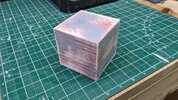lucavigg
New Member
I'm currently coming to the end of a Thunderbird 1 build, based on a set of STL files from Gadgetmind on Thingiverse. Initially, I was going to get some vinyl lettering cut out for the vertical THUNDERBIRD on the main fuselage from nose to tail. However, I'm not sure vinyl would stick correctly, given I've already painted the fuselage.
I've tried scoring and cutting some 0.25mm styrene (picture) on my Silhouette cutter but it's difficult to get super accuracy on the position of each letter.
Is there a way of printing a single custom waterslide decal in white so that each letter has a transparent gap around it?
Thanks

